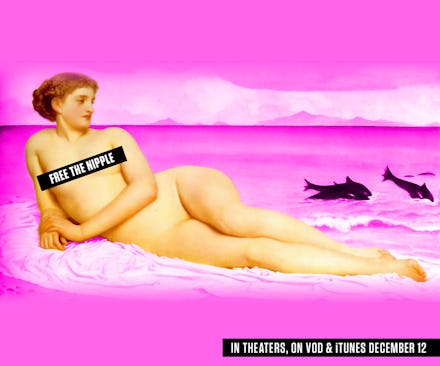Meet the Activist Who Wants Women Everywhere to 'Free the Nipple'

Most American cities are full of breasts. They are everywhere: On billboards. On storefronts. On buildings. But if you look closely, there's consistently one thing missing: nipples. Although a handful of states technically allow women to go completely topless, those in many places can be arrested for doing so.
That's something Lina Esco is combatting with Free the Nipple, a movement she founded to fight against sexist public nudity laws that unfairly target women.
We live in a culture that's obsessed with women's breasts. They are glamorized, fetishized and over-exposed. They are sexualized and gratuitously emphasized in film, television and magazines. It's clear we're often more fascinated by women's breasts than who they are as people; in film, for example, although women are less likely to have speaking roles than men, they are more likely to appear naked on screen.
If our society loves boobs so much, what does it have against nipples? This is the basis behind the ideology of the movement, and an issue succinctly highlighted by an enlightening exchange Esco once had with a 7-year-old girl. In reference to women's nipples, the child asked Esco, "Why is that we can sell them, but we can't wear them?"
That query highlights the contradiction of a society that commodifies women's sexuality yet legislates their bodies. "You can objectify her breasts, but a woman can't own her body," Esco told Mic.
Some nipples actually are easy to find: Men's. Topless men abound on YouTube, on television and even greeting shoppers outside clothing stores. For the most part, public obscenity laws only apply to women, and only women's chests are deemed indecent.
Surprisingly, this double standard wasn't always quite so extreme. Judge Herman Walz, one the first people to hear a landmark 1986 case over gender inequality in topless laws, wrote in his decision, "community standards do not deem the exposure of males' breasts offensive," the Atlantic reports. Yet a quick look at history shows that men's chests used to be perceived to be as obscene in many part of the United States.
Topless men in movies, for instance, were generally frowned upon until 1934, when Clark Gable took off his shirt during a scene in It Happened One Night. According to Go Topless, a website dedicated to tracking anti-topless laws, this marked the first time a man had removed his shirt on film without sporting an undershirt.
Toplessness was also illegal in public, even on many beaches; for a long time, men had to cover their chests just like women did in places like Atlantic City and Long Island, or risk being fined. In 1936 it became legal for men to go bare-chested in Coney Island, an example Esco likes to use to point out the double-standard in New York legislation. "We have so many laws about women's bodies and none about men's," she told Mic.
Esco started Free the Nipple to revolutionize the way we perceive women's bodies. What began as an idea for a fiction film has become a larger movement about gender equality. Esco's ultimate goal is the end of legislations constraining women's bodies in public spaces, and for women and men to have equal ownership over their bodies.
"Just because our movement is called 'Free The Nipple' doesn't mean we want the whole world to go on a topless revolution. It's about having that right and that choice," Esco said.
Breasts are just the tip of the feminist iceberg. Esco also told Mic she views the nipple as a sort of "Trojan Horse" issue. "Equality in terms of toplessness applies to the censorship of women's bodies on social media, the issue of equal pay, or the stigma against breastfeeding in public. It all falls down in the same category, which is equality."
The offense taken at the sight of nipples is all the more ridiculous when considered in light of the violent images often thrown across our screens. "The nipple has been hidden for so long on network television and magazines that now that it's peeking out for a bit, everybody is freaking out. But then you turn the television and you see so much violence," Esco said.
"Women's breasts are not the problem," Soraya Chemaly, one of the activists who lobbied Facebook to end the censorship of women's breastfeeding photos, told Mic. "Sexual objectification is the problem. There's a difference between sexualization and sexuality. Breasts don't hurt children, breasts feed children, and it's the sexualization of women's bodies that's actually hurting children the most."
This societal sexualization is likely why many of the men Esco encounters in everyday life claim that they would be too distracted and turned on if women walked around topless. Her response to such arguments is simple: "Would you still feel aroused and distracted if I sat in front of you topless for five hours?"
Besides, as Jessica Valenti recently argued in the Guardian, "Is it really women's responsibility to hide the well-established fact that most of us have nipples, or is it men's not to be such damn oglers?"
Laws that force female nipples into hiding are similar to dress codes targeting young girls in that they police only women's bodies and turn them into objects that must be covered up, rather than assert that women should have agency over themselves. "This idea of hiding women up is as objectifying as stripping them naked," Chemaly said.
Let women breathe. Let's start with letting our nipples be free. They've been in hiding for far too long.